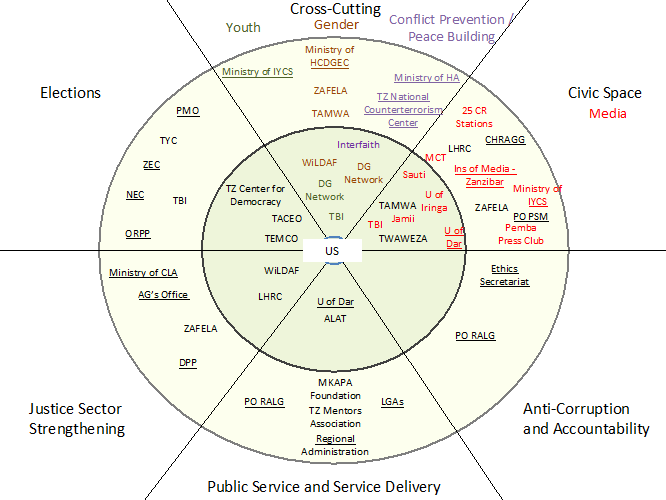Collaborating to Improve Development in Tanzania
Andrew L. Greer, Ph.D. is a Program Specialist in Monitoring, Evaluation, and Learning for the Learning Division in USAID's Center of Excellence on Democracy, Human Rights, and Governance. For more information, email Andrew: [email protected].
Siloed programming hinders development work. Without collaboration, development efforts in recipient countries can suffer from a lack of efficient programming. In other words, development partners such as USAID, UK’s Department for International Development (DfID), and others might be unaware of each other’s programming. For development efforts to be as efficient and strategic as possible, USAID missions should take steps to understand what other development partners are doing.
Collaborating as a First Step to a Coherent Strategy
Resources on both ProgramNet (for USAID staff) and Learning Lab (for USAID staff and partners) offer advice about how to be strategic when collaborating and provide suggestions for improving external collaboration. Further, the Bureau for Policy, Planning and Learning (PPL) offers a number of tools for informal network mapping or collaboration mapping (note that this tool did not have the right parameters for our needs, so we did not use it to develop the maps below). Yet this advice tends to focus on collaboration between USAID missions and implementing partners, with less written about country-level collaboration across development partners, NGOs, and in-country government offices. The following section includes an example of collaboration mapping across development partners in Tanzania as a first step in creating a coherent Democracy, Rights, and Governance (DRG) strategy at the country level.
Collaboration Mapping with the USAID/Tanzania DRG Team
To increase efficiencies of work across development partners in Tanzania, the DRG Team recently conducted a collaboration mapping exercise. The team carried out the mapping in four steps:
- First, the DRG team surveyed 18 development partners to understand the focus of their collective work across Tanzania. The areas of focus from the survey results included elections, civil space, anti-corruption, public service, justice-sector strengthening, and cross-cutting issues (i.e., gender, youth, peace building). In addition, a follow-up survey asked partners to rank NGOs and government offices from closest partners to more peripheral partners for each of the focal areas.
- Second, the DRG team plotted the results on a set of collaboration maps in PowerPoint for each partner (see example from USAID below). The team workshopped the maps with 30 representatives from the group of development partners at the monthly meeting for the Development Partners - Governance Working Group. For each development partner, representatives described their map and suggested ways to more accurately visualize their relationships with NGOs and government offices.
- Third, the DRG team calculated the numbers of overlapping relationships across development partners. Almost 50 NGOs and over 10 government offices worked with more than one development partner, which further underscores the need for partners to understand who’s working with particular NGOs and government offices.
- Finally, the DRG team updated the maps based on partner feedback. Because they were made with basic software (PowerPoint), the maps will be easily updated when partners discuss collaboration at least every six months.
Example of Basic Collaboration Map from USAID

In the next Governance Working Group meeting of development partners, partners will use this information to further refine their joint strategy on future programming with local NGOs and government offices. After beginning the work of breaking down siloes with collaboration mapping, donor partners in Tanzania will refine their strategy to make future programming more efficient than it is currently. These initial steps have the ultimate goals of reducing siloed programming and improving DRG development in Tanzania.



